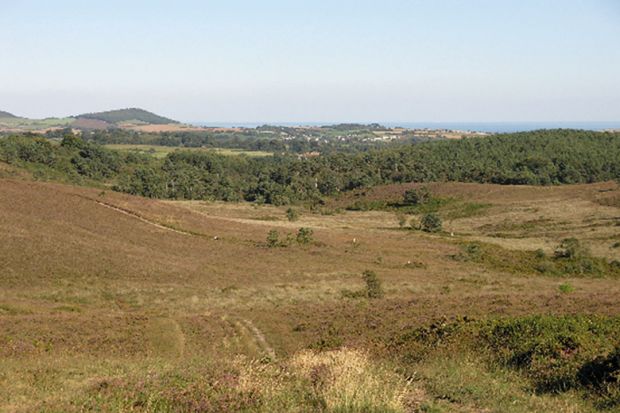What is landscape but the land we hold in our heads? The land we imagine, named and catalogued in relationship to ourselves. But we are a part of, not apart from, what lies around us. We have defined it as much as it has defined us. We are inseparable. The land is what we are made of, after all. “We are not somehow outside it, or contained by it; landscape is”, say the authors of this book, “a thing in which we move and think. Therefore we cannot think of it in any way we like.” It is already laden with meaning.
We anthropologise the landscape every day. We measure it as we traverse it. We look down on it. We change it, even by thinking about it. Taking a particular slice of southwest England, the Pebblebed heathland south-east of Exeter, Christopher Tilley and Kate Cameron-Daum embark on a contextual study, to document as much as to understand where we are now. It is, if you will excuse the pun, a fertile field. For all its hugeness – its exposure in art and culture, in usage and dispute, landscape is “an absent presence in a huge body of scholarship”. Only in the past 25 years, they say, has a new academic focus been brought to bear on the subject. In the wider world, the work of writers such as Robert Macfarlane and Tim Dee has popularised a human interrogation of the cultural meaning of the landscape. In many ways, they are just catching up with ideas that art, literature, myth and folklore have long been concerned with. But academics have their checklist – Biography, Place, Motility, Mediation, Agency, Aesthetics and Well-being, Conflict and Contestation, Nature and Culture – the manifold ways in which their patch is put to use.
Heathland is a much modified landscape – burned-over, tramped-over; foraged by cattle and ponies; partly industrialised, yet at the same time a fragile ecosystem for rare lizards and evanescent butterflies. In a lovely chapter – “Bushes that move: the Royal Marines” – the authors examine the way that the soldierly body (in all its nuances) impacts on the land on which they train, leaving their mammalian traces, “their own network of tiny ‘sheep tracks’”. Cyclists contend that they do less damage to the heath than horse-riders. Painters take their own pleasure, sometimes not straying too far from their cars for fear of the “wilderness”. It is these experiences that this book captures, “endless diversity, flows of meaning and significance in situated small acts”.
As beautiful as a heath is, it is a mosaic of such acts: a communal human-natural cooperation; perhaps even a microcosm of Britain. What emerges most strongly from An Anthropology of Landscape is its authors’ own love for their work; it is telling that the book is dedicated to Tilley’s dog, Tor, “who knew the heath better than either of us”. Out of the apparently arbitrary, meaning is shared: I’m reminded of W. G. Sebald, another great interrogator of landscape, who compared his writing to walking his dog in a field where she would wander, sniff here and there, and tell her own story.
Philip Hoare is professor of creative writing, University of Southampton, and author, most recently, of The Sea Inside (2013).
An Anthropology of Landscape: The Extraordinary in the Ordinary
By Christopher Tilley and Kate Cameron-Daum
UCL Press 320pp, £40.00, £22.99, free
ISBN 9781911307457, 07440, 07464 (e-book), 07433 (open source e-book)
Published 1 February 2017
POSTSCRIPT:
Print headline: Devonian pastoral
Register to continue
Why register?
- Registration is free and only takes a moment
- Once registered, you can read 3 articles a month
- Sign up for our newsletter
Subscribe
Or subscribe for unlimited access to:
- Unlimited access to news, views, insights & reviews
- Digital editions
- Digital access to THE’s university and college rankings analysis
Already registered or a current subscriber? Login




